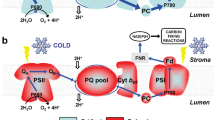Abstract
The effects of various factors on the electrofusion efficiencies ofPorphyra protoplasts were investigated. These factors were protoplast stabilizing reagents, divalent cations, membrane digestive enzymes and cold storage of the protoplasts. Fusion efficiencies were dependent on the concentrations of reagents used to adjust the osmotic pressure of the medium. With mannitol or sorbitol the maximum fusion efficiency (approximately 16%) was observed at concentrations of 0.6 to 0.7 M; glucose was less effective. Brief treatment of the protoplasts with pronase stimulated electrofusion, whereas treatment with proteinase K, trypsin, phospholipase C or lipase repressed fusion. The addition of Ca2+ at 10-5 to 10-4 M in the protoplast medium enhanced the fusion efficiency to approximately four times that of the non-treated control. Sr2+ and Co2+ also stimulated electrofusion, but less effectively than Ca2+. The fusion capacity of the protoplasts remained stable for about 3 h when kept on ice, but decreased gradually when left at room temperate.
Similar content being viewed by others
References
Araki T, Morishita T (1990) Fusion of protoplasts from wild typePorphyra yezoensis and green typeP. tenera thalli (Rhodophyta). Nippon Suisan Gakkaishi 56: 1161.
Bates GW (1985) Electrical fusion for optimal formation of protoplast heterokaryones inNicotiana. Planta 165: 217–224.
Bates GW, Gayhor JJ, Shekhawat NS (1983) Fusion of plant protoplasts by electric fields. Plant Physiol. 72: 1110–1113.
Bates GW, Hasenkampf CA (1985) Culture of plant somatic hybrids following electrical fusion. Theor. appl. Genet. 70: 227–233.
Chapel M, Teissie J, Alibert G (1984) Electrofusion of spermine-treated plant protoplasts. FEBS Lett. 173: 331–336.
Chen THH, Kartha KK, Constabel F, Gusta LV (1984) Freezing characteristic of culturedCatharanthus roseus (L). G. Doncells treated with dimethylsulfoxide and sorbitol in relation to cryoperservation. Plant Physiol. 75: 720–725.
Fujita Y. Migita S (1987) Fusion of protoplasts from thalli of two different color types inPorphyra yezoensis Udea and development of fusion products. Jap. J. Phycol. 35: 201–208.
Fujita Y, Saito M (1990) Protoplast isolation and fusion inPorphyra (Bangiales, Rhodophyta). In: Lindstrom SC, Gabrielson PW (eds), Thirteenth International Seaweed Symposium. Developments in Hydrobiology 61. Kluwer Academic Publishers, Dordrecht, 161–166. Reprinted from Hydrobiologia 204/205.
Kao KN, Michayluk MR (1974) A method for high frequency intergeneric fusion of plant protoplasts. Planta 115: 355–367.
Lovelock JE, Bishop MWH (1959) Prevention of freezing damage to living cells by dimethylsulphoxide. Nature 183: 1394–1395.
Menczel L, Wolfe K (1984) High frequency of fusion induced in freely suspended protoplast mixtures by polyethylene glycol and dimethylsulfoxide at high pH. Plant Cell Reports 3: 196–198.
Mizukami Y, Okauchi M, Kito H (1992) Effects of cell walllytic enzymes on the electrofusion efficiency of protoplasts fromPorphyra yezoensis. Aquaculture 108: in press.
Morikawa H, Asada M, Yamada Y (1988) Effects of physical parameters upon protoplast electrofusion. Plant Cell Physiol. 29: 659–664.
Morita R, Zobell CE (1955) Occurrence of bacteria in pelagic sediments collected during the Mid-Pacific Expedition. Deep-Sea Res. 3: 66–73.
Nea LJ, Bates GW (1987) Factors affecting protoplast electrofusion efficiency. Plant Cell Reports 6: 337–340.
Ohno-Shosaku T, Okada Y (1985) Electric pulse-induced fusion of mouse lymphoma cells: Roles of divalent cations and membrane lipid domains. J. Membrane Biol. 85: 269–280.
Pilwat G, Richter HP, Zimmerman U (1981) Giant culture cells by electric field-induced fusion. FEBS Lett. 133: 169–174.
Reddy CRK, Fujita Y (1989) Protoplast isolation and fusion ofUlva pertusa andU. conglobata. In: Miyachi S, Karube I, Ishida Y (eds), Current topics in marine biotechnology. The society of marine biotechnology, Tokyo: 235–238.
Ruzin SE, McCarthy SC (1986) The effect of chemical facilitators on the frequency of electrofusion of tobacco mesophyll protoplasts. Plant Cell Reports 5: 342–345.
Saito M, Fujita Y (1991) Optimization of fusion conditions in the polyethylene glycol and the electric stimulation methods for the protoplasts ofPorphyra. Nippon Suisan Gakkaishi 57: 919–925.
Spangenberg G, Schweiger HG (1986) Controlled electrofusion of different types of protoplasts and subprotoplasts including cell reconstitution inBrassica napus L.. Eur. J. Cell Biol. 41: 51–56.
Tempelaar MJ, Duyst A, De Vlas SY, Krol G, Symmonds C, Jones MGK (1987) Modulation and direction of the electrofusion response in plant protoplasts. Plant Sci. 48: 99–105.
Tempelaar MJ, Jones MGK (1985) Fusion characteristics of plant protoplasts in electric fields. Planta 165: 205–216.
Vienken J, Zimmerman U, Fouchard M, Zagury D (1983) Electrofusion of myeloma cells on the single cell level. Fusion under sterile conditions without proteolytic enzyme treatment. FEBS Lett. 163: 54–56.
Watts JW, King JM (1984) A simple method for large-scale electrofusion and culture of plant protoplasts. Biosci. Rep. 48: 99–105.
Zimmerman U (1982) Electric field-mediated fusion and related electrical phenomena. Bichem. Biophys. Acta 694: 227–277.
Zimmerman U, Pilwat G, Phol HA (1982) Electric field-mediated cell fusion. J. biol. Phys. 10: 43–50.
Zimmerman U, Scheurich P (1981) High frequency fusion of plant protoplasts by electric fields. Planta 151: 26–32.
Author information
Authors and Affiliations
Rights and permissions
About this article
Cite this article
Mizukami, Y., Kito, H. & Okauchi, M. Factors affecting the electrofusion efficiency ofPorphyra protoplasts. J Appl Phycol 5, 29–36 (1993). https://doi.org/10.1007/BF02182419
Received:
Revised:
Accepted:
Issue Date:
DOI: https://doi.org/10.1007/BF02182419




